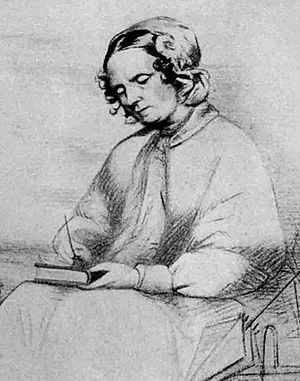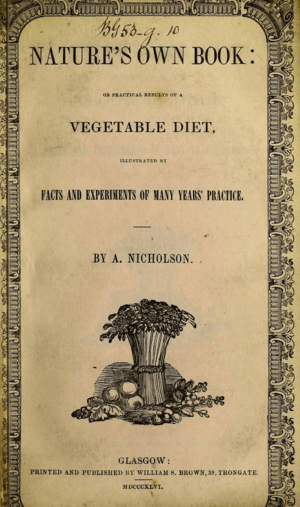Asenath Nicholson facts for kids
Asenath Hatch Nicholson (born February 24, 1792 – died May 15, 1855) was an American woman who cared deeply about others. She was a vegan, which means she chose not to eat any animal products. She was also a "social observer," meaning she carefully watched and wrote about how people lived. As a "philanthropist," she worked to help people in need.
Asenath Nicholson is well-known for her writings about the Great Hunger in Ireland during the 1840s. She traveled through the country, seeing firsthand how people lived before and during the time when potato crops failed. While she walked, she also gave out Bibles, food, and clothes to those who needed them.
Contents
Life Story
Asenath Nicholson was born in Chelsea, Vermont, in 1792. Her family belonged to the Protestant Congregation Church. She was named after a person from the Bible, Asenath, who was the wife of Joseph.
She became a successful teacher in her hometown. Later, she married Norman Nicholson, who already had three children. They moved to New York. The family became very interested in a special diet suggested by Sylvester Graham. This diet was mostly vegetarian. In the 1840s, they even ran a boarding house that served these vegetarian meals. Asenath also believed in regular exercise and sometimes not eating for a short time (called fasting) to stay healthy. She was the first person to publish recipes based on Graham's diet.
Traveling to Ireland
In May 1844, after her husband passed away, Asenath left New York and traveled to Ireland. She walked all around the country, visiting almost every area. She noticed that many people did not have jobs and relied almost completely on their potato crops for food. In August, she left for Scotland. She had seen Ireland just before the terrible Irish Famine began.
When she returned to America, she wrote a book called Ireland's Welcome to the Stranger. It was published in 1847. In the book, she shared her experiences and observations from her travels in Ireland.
Asenath was very good at noticing unfairness and how some people were treated badly. For example, she explored the grounds of Clifden Castle in Connemara. There, she found a beautiful cave-like structure called a grotto. She wrote about it: "Now appeared a fairy castle, a house with variegated pillars and open door, made of shells of the most delicate shades, arranged in stars and circles of beautiful workmanship. These showed exquisite taste in the designer, and must have been done with great cost and care. I found that a laboring peasant was the architect of this wonderful fabric, but he was kept most religiously in his rank, laboring for eight pence a day." This showed how a talented worker was paid very little for his amazing work.
In a town called Roundstone, a man told her that potatoes were "The greatest curse that ever was sent on Ireland." He said that because people could live on potatoes, landowners paid them very low wages. Asenath agreed, saying it was a "pithy truth" she had never seen so clearly.
Helping During the Famine
Asenath returned to Ireland in 1846. This was during the second year of five years of potato crop failures. The poor people of Ireland depended on these potatoes. The crop failures, along with high unemployment, were causing a huge disaster across the country.
Asenath was worried she would only be able to watch the suffering. But she decided to act. She wrote to two newspapers in New York, the New-York Tribune and The Emancipator. Readers of these newspapers organized help. In July, five barrels of corn arrived from New York for her to distribute. The same ship also carried 50 barrels for a larger group called the Central Relief Committee. However, Asenath preferred to work on her own to help people directly.
She wrote another book, Annals of the Famine in Ireland, 1847, 1848 and 1849. This book was her eyewitness account of the Great Hunger in the 1840s. She wrote about what she saw as she walked through the country, giving out Bibles, food, and clothing.
Asenath Nicholson passed away in Jersey City in 1855.
Her Beliefs on Food
In 1835, Asenath Nicholson wrote the first American cookbook for vegetarians. It was called Nature's Own Book. She believed that "good bread, pure water, ripe fruit, and vegetables are my meat and drink exclusively." While her book included some recipes with dairy products, Asenath herself did not use them.
She also wrote another book called Kitchen Philosophy for Vegetarians. This book was published in 1849. A review of the book noted that it did not use butter or eggs in its recipes. Because of this, The Vegan Society has called it the first vegan cookbook.
Selected Publications
- Kitchen Philosophy for Vegetarians (1849)
- Loose Papers: Or, Facts Gathered During Eight Years' Residence in Ireland, Scotland, England, France, and Germany (1853)



